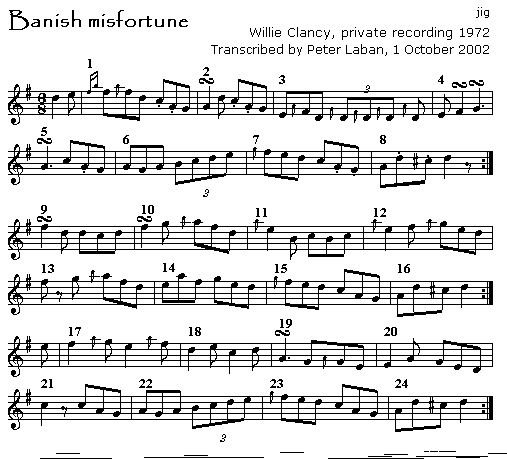From a private tape, recorded August 1972
Comments and transcription by Peter Laban, 1 October 2002

Banish misfortune is a common three-part double jig. O'Neill gives a version with parts reversed and some overall problems in the notation but Breathnach has a fine version from the piping of John Potts [CRE 1, no 38]. The late Patrick Kelly, fiddle player from near Cree, Co Clare had an elaborate version of the tune, one Willie also played, which he called The shady groves of Peamount (Peamount was Ireland's TB hospital during the first part of the 20th century).
Willie Clancy played different versions of the tune on the pipes, one similar to the one under investigation here and one more elaborate. Willie had some tunes that according to him could be played "the jig way" or "the piece way". The "piece way" is a slowed down highly ornamented version of a tune, great examples of this from Willie's playing are his treatment of The humours of Glin and Nora Criona. One of his versions of Banish misfortune could be considered as having received some of the "piece" treatment, starting off on an elaborate run of quadruplets, a version he picked up from fiddleplayer Patrick Kelly.
The present version is however closer to the usual way of playing a jig Willie takes the tune slowly though and dwells on a number of features of the tune. Although played on the whistle Willie's treatment of the tune overall is very reminiscent of his piping: he uses a number of staccato runs that in fact replicate his piping versions, he also introduces a double cran on D in the tune - which puts to rest the myth that Matt Molloy was the first to employ this technique away from the chanter.
The most remarkable feature of the playing here is however Willie's use of sliding c and f. In an interview taken a few months before his death Willie talked about he most important notes in the expression of the music: f-natural and c-natural (please note that the pitch of these notes is often not actual "natural" but sharp from that while still distinctly flat from the sharp end. I personally prefer the use of the term c or f "neutral" to indicate that the pitch moves somewhere in between natural and sharp). His use both notes, taken from Sean Nos singing but wonderfully employed in dance music, is one of the outstanding features of his piping, and as we see here he used them equally expressively in his whistle playing.
The playing opens with a long characteristic slide on f: the note is bent right from e through f-natural towards the f-sharp - a device Willie often used in both his piping and his whistleplaying to add great colour and expression to his music. Bars 1 and 2 see him replicating an effect resembling tight fingerings as used on the chanter. Another piping device crops up in bar 3, where Willie uses a cran. In this case the note cranned is preceded by a note of the same pitch so Willie uses the double crann; please note the use of a triplet in the notation, the first three cuts are grouped together and the melody notes of equal length, then there is a dliberate pause before the A cut which is strong and distinct. The overall rhythm of the crann is dadada-dum (thanks to Pat Mitchell for the description of the cran). The F roll in Bar 4 has another slide from E, I tried to visualise the efect by writing a short roll preceded by E. Throughout the second part Willie continues playing with the pitch of the F and C but it's only in bar 17, opening the third part, that he colours the note to its full potential - adding to the effect by cutting the offbeat notes, another device he employed throughout his playing and to great rhythmic effect. Bar 20 sees another big F neutral slide starting from the E in the preceding bar.
Overall a wonderful expressive treatment of the jig. As often in Willie's playing there is an abundance of small rhythmic shifts from one playing to the next there is also quite a variety in the treatment of the C and F, the transcription only gives you the dots and it is crucial to listen closely to the soundclip and hear the actual music.
About the transcription, as usual, I have only written what I thought I heard, I have made no attempts at indicating where and to what extent the pitch of the various notes was bent. This is a matter for you own ears. There was a slight glitch in the opening bar of the second part, I have omitted that bar and replaced it by the opening bar of the repeat of the second part.
Peter Laban, 1 October 2002